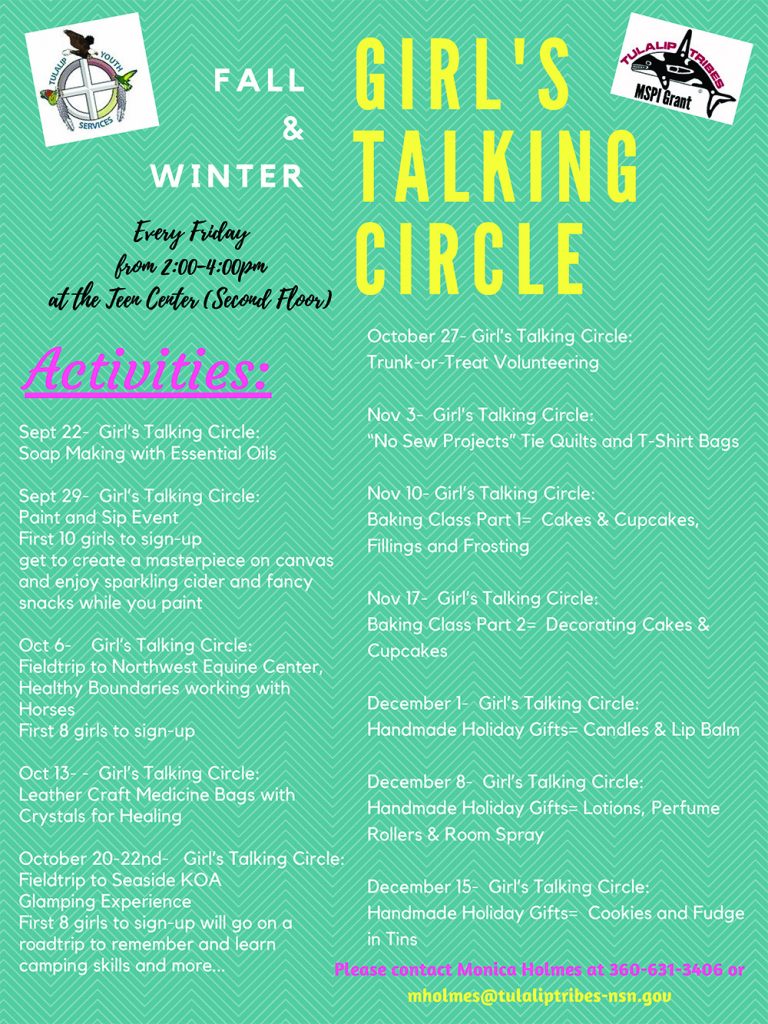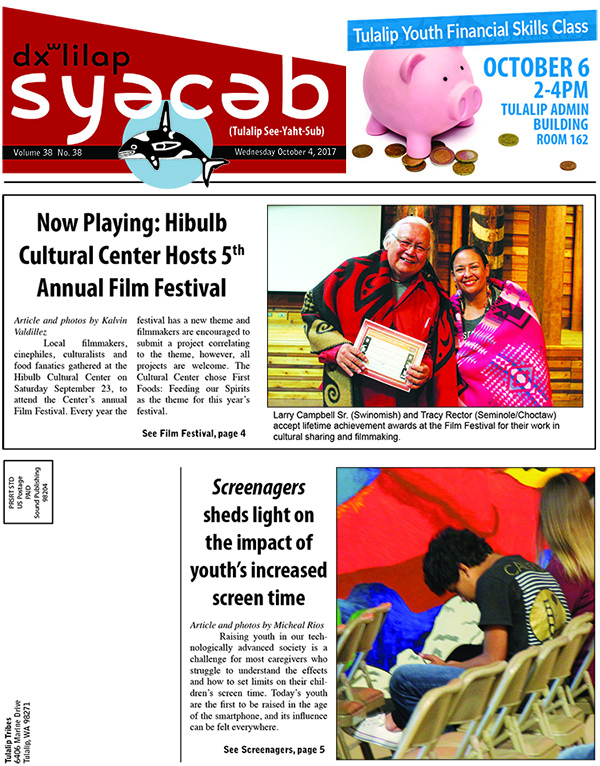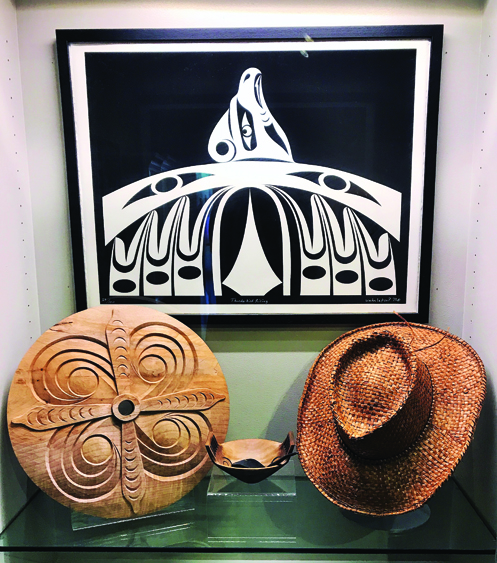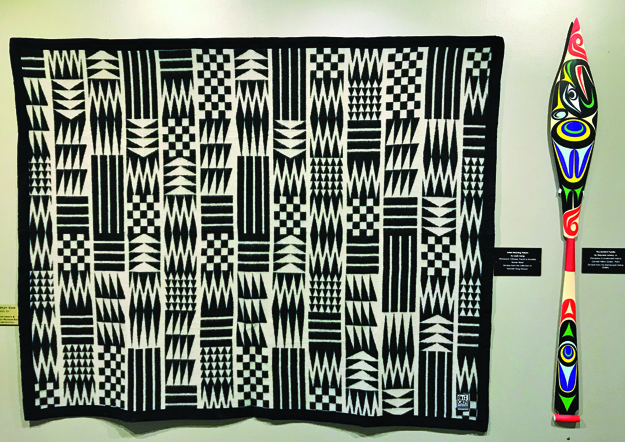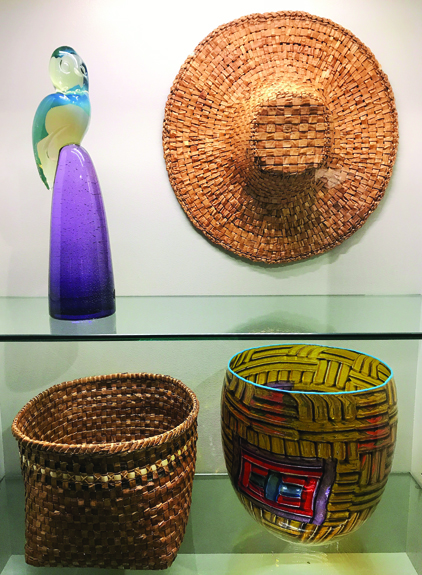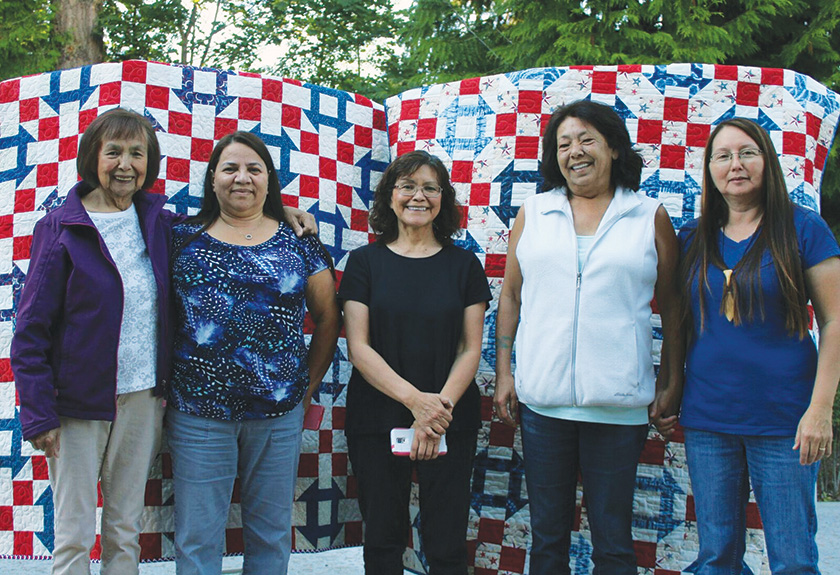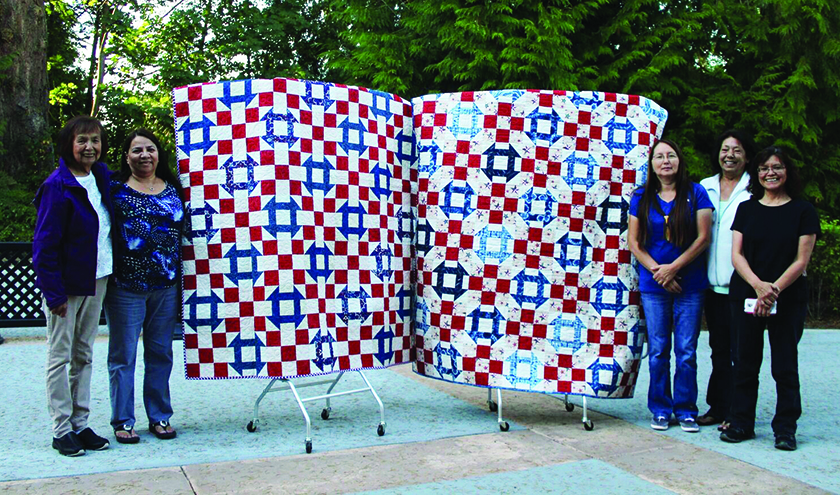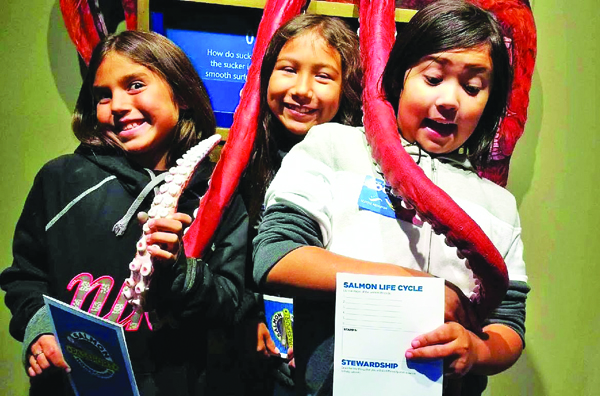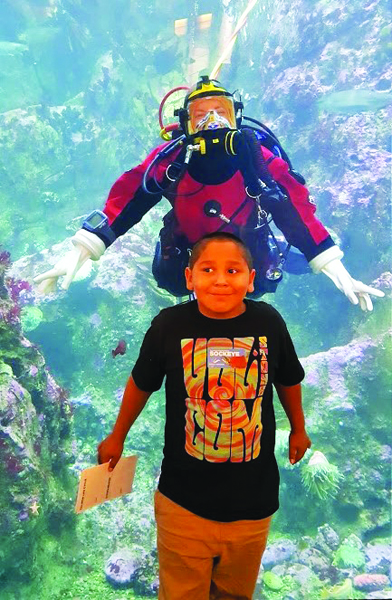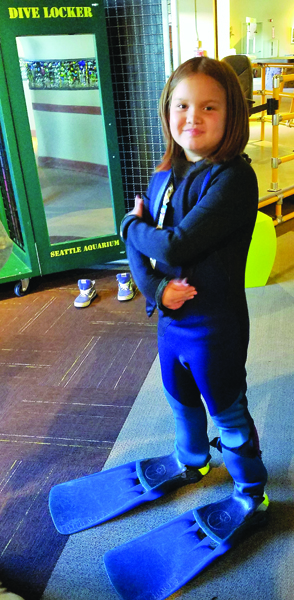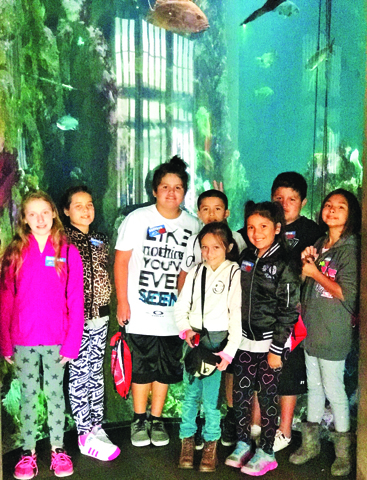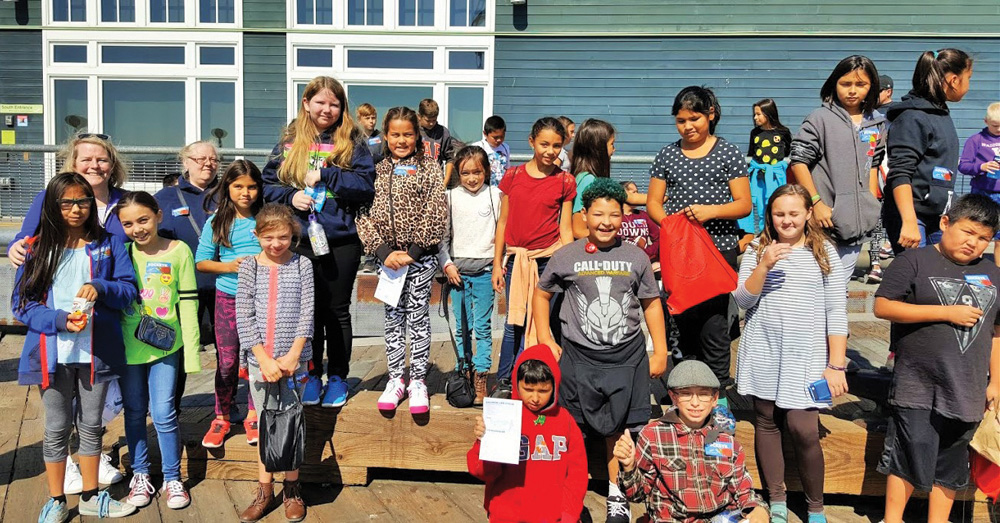The Girl’s Talking Circle includes hands-on art and crafts, explores cultural identity, focuses on personal, team and community building, enjoys field trips, and features speakers from the tribe that share their wisdom and skills.
Author: Kim Kalliber
October 4, 2017 syəcəb
Please use the following link to download the October 4, 2017 issue of the syəcəb:
https://www.dropbox.com/s/y37hxegomtgg2x6/October%204%2C%202017%20sy%C9%99c%C9%99b.pdf?dl=0
“A Journey to a Healthier You,” Featuring Kenn Johnson

By AnneCherise Jensen, Tulalip Tribes SNAP-Ed Nutritionist
Kenn Johnson, member of the Colville Tribe and Tulalip Police officer for 11 ½ years, has spent the last year transforming himself into a happier and healthier version of himself. Also a member of the Tulalip Walking Club, Kenn has made a huge transformation in lifestyle change and has managed to lose an outstanding 66 pounds over the last year as a result. Kenn feels happier and healthier than he has in the last 20 years! Here is his story….
It was back in early 2016 when Kenn walked into the doctors and was told he had high blood pressure, high cholesterol, was at a very unhealthy weight, was suffering from chronic arthritis and had other serious medical conditions that put Kenn in a lot of pain and discomfort. At his heaviest weight, 287 lbs., Kenn was at the breaking point where he simply just wanted to give up on himself. This meant giving up his hobbies, his health, his dreams and his future. Kenn had tried many diet programs in the past where nothing seemed to consistently work, or consistently keep the weight off. Despite the fact, Kenn was a fighter and made the decision he wasn’t going give up. It wasn’t until a ferry ride home when Kenn ran into an old friend who had recently lost a lot of weight. On the ferry ride, they discussed the benefits of a diet and exercise program that had truly worked for her. It was a program that offered a health coach, a meal plan, and an accountability program. So on September 8th 2016, Kenn decided to take a chance and start the program.
Once starting the program, Kenn immediately changed his diet and quickly began seeing results. Kenn states, “It was the drastic change in my diet alone that helped me lose my first 40 pounds.” Kenn’s diet consisted of eating mostly whole grains, lean proteins, healthy fats, and lots of fruits and vegetables. Kenn also adds, “I put an alarm on my phone to go off every three hours. This reminded me to eat small, healthy snacks every three meals to keep my metabolism moving fast.” Other major changes Kenn made included completely cutting out high fructose corn syrup and other simple sugars out of his diet. Instead he replaced them with nutrient dense foods that kept him feeling properly fueled and energized throughout the day.
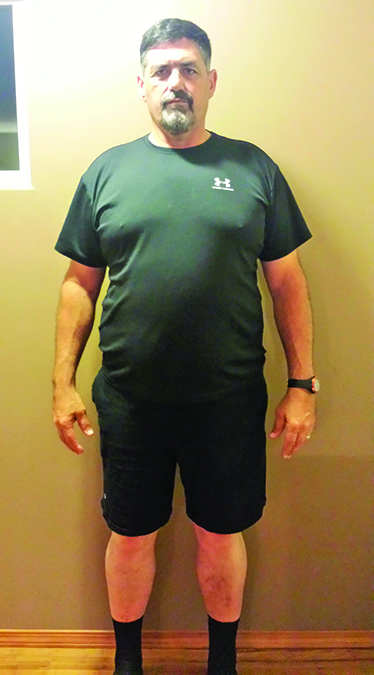
In early January, after receiving a Fit Bit for Christmas, Kenn also decided he wanted to become more active, so he began walking on a daily basis. Kenn’s first goal was to reach 8,000 steps a day, approximately 4 miles. He continually met his goal and made a new goal to reach 11,000 steps a day, approximately 5.5 miles. To this day, Kenn successfully averages 25-35 miles a week. “As soon as you get used to walking a lot, it’s like your body is on auto pilot and its gets easier every time,” says Kenn.
As a member of the Tulalip Walking Club, Kenn loves attending our walks and is an inspiration to other members of the club. Not only that, but he makes us all feel extra safe walking throughout the community. Thanks Kenn!
Overall, through diet and exercise Kenn claims that his quality of life has increased tremendously. His blood pressure, cholesterol and triglycerides are now at above healthy levels. He is thinner that he has ever been in the last 20 years, the pain from the arthritis is gone, and he has more energy and vitality. Kenn’s advice to anyone who wants to make a healthy lifestyle change is to JUST GO OUT AND DO IT! It’s an all-in commitment and it’s a choice. It’s not something that is going to happened over night, it’s not going to be easy, but there are so many incredible benefits to losing weight. “It was definitely worth all the pain and sweat,” Kenn states. “Not only are you losing weight, but the greatest benefits come from the unseen changes. The changes in mood, the changes in self-esteem, the medical benefits, the confidence and the courage to take on your fear. Anything seems possible now!”
Salish Modern: Innovative Art with Ancient Roots
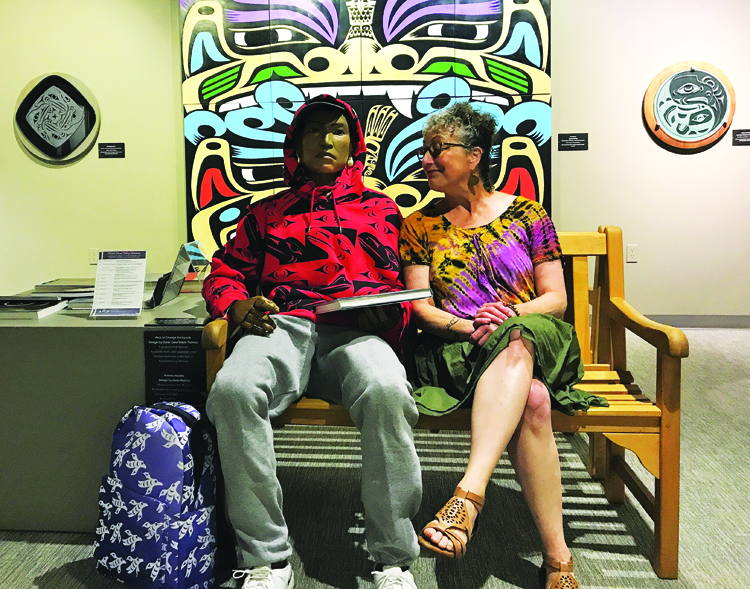
By Micheal Rios, Tulalip News
Thirty years ago, you couldn’t find a map using the term “Salish Sea” for the Puget Sound region. There were Seattle galleries and t-shirt shops aplenty selling Northwest Coast Native art, but the masks, totem poles and sinuous formline animal prints were designs from hundreds of miles away, not from here.
Thirty years ago, no major art museum in Washington had mounted an exhibit highlighting Native created works of our own lands and waters. Artists were indeed working – Musqueam visual pioneer Susan Point was making innovative prints based on ancient carved designs. Ron Hilbert was painting bold scenes of spiritual practices and Lummi weavers Bill and Fran James were making sumptuous blankets and intricate baskets. But the critical interest and most gallery attention was focused on art from the Canadian coast.
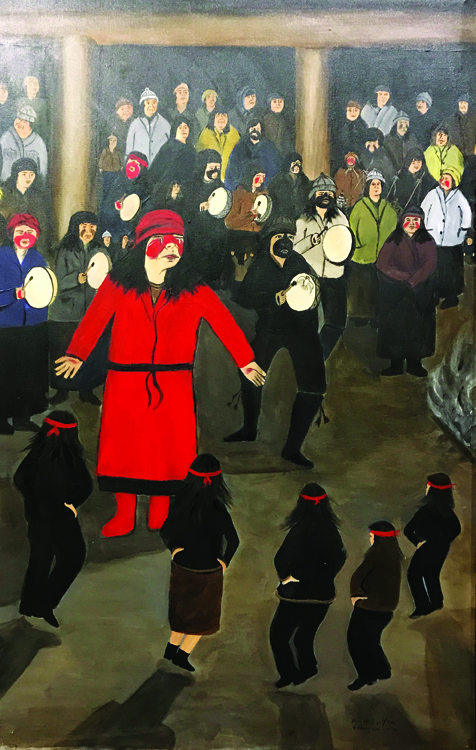
In 1989, the balance started to tip. Washington State’s Centennial exhibit of Native arts opened, managed by Patricia Cosgrove (now Director of the White River Valley Museum) with Kenneth Watson as part of the exhibit staff. Both art historians were on a mission to convince Seattleites that totem poles are not indigenous and that Salish art in all its creative branches is. The exhibit was incredibly successful, and soon many influences aligned to literally change the landscape of the Native art market.
Ever since, both Cosgrove and Watson have worked hard to see the word ‘Salish’ enter the mainstream vocabulary, and to insure that the characteristic sweeping lines and subtle patterns of Salish arts become recognizable and emblematic of the Seattle area.
Through the effort of many, this vision has come true. High quality galleries like Seattle’s Stonington Gallery and Steinbrueck Native Gallery feature experienced and rising artists from across the Salish Sea region. Generations of new artists have risen in skill and popularity. Today, Salish art is an explosion of innovation and creativity that still has a firm foundation in our region’s earliest Salish generations.*
That innovation and creativity of Coast Salish artistry is currently on full display at the White River Valley Museum, located in Auburn only blocks away from the Muckleshoot Reservation. Inside the museum mounts an unprecedented six-month-long exhibition titled Salish Modern: Innovation Art with Ancient Roots.
“I’m really thrilled that we have works from artists who are rock stars in the Native art world, such as Louie Gong (Nooksack), Susan Point (Musqueam), and Shaun Peterson (Puyallup),” states Patricia Cosgrove, Museum Director and Salish culture enthusiast. “People are surprised when they see the ancientness of the tradition and then recognize the elements of it all around them in these very modern pieces. This is a perfect exhibit to celebrate this vital, fabulous modern art world.
“For museum visitors and people who see the exhibit, I’d like them to know that Salish cultures are alive and can be very modern. In my opinion, modern Salish art is some of the most elegant, divine visuals that you can find,” continues Patricia. “I’d love to see Salish art take the place of totem poles and form line design in Seattle as its visual identity.”
Salish Modern: Innovation Art with Ancient Roots will be on display through December, 17. The exhibit is supported in part by the Tulalip Tribes Charity Fund. Included among the many elegant Salish artworks is a rare painting by Ron “Chadusqidub” Hilbert (Tulalip and Upper Skagit) depicting a ceremonial smokehouse dance from 1989.
*source: Salish Modern exhibit material
Quilting for Tulalip Veterans
By Kalvin Valdillez, Tulalip News
Over the past two months, seven Tulalip tribal members have been hard at work crafting quilts for the Veterans of Tulalip. The members of the quilting group are Sandra Swanson, Candy Hill-Wells, Lena Jones, Sara Andres, Benita Rosen, Sherry Dick and Rae Anne Gobin. In Native America, blankets hold a significant value to many tribal communities as they are associated with honor and respect. Blankets, including quilts, are traditionally gifted at various ceremonies such as potlatches, pow wows and graduations. Tulalip quilters have used their artwork to help strengthen their community for many generations by gifting them to honor their fellow tribal members.
“Tulalip Tribes had a group of quilters that gathered at the ‘Fudge ‘n Funnies’ quilt store in Marysville until the store had a fire and closed,” explains Quilter Rae Anne Gobin. “Since then, there hasn’t been a place for quilters to gather until the Hibulb Museum was built. In 2016, I attended a Star Quilt class at the museum, taught by Edith Johnny and Tisha Mclean. It was then, the passion for quilting sparked once again.
“Outside of making quilts for family what else could I do?” Rae Anne pondered. “I thought about my grandmother, Christina Fryberg Williams, who belonged to the women’s sewing group housed at the basement of the old dining hall called the ‘thrift shop.’ I remember hanging out with my grandmother and cherished the quilt she gave me. Then, thinking of my dad, Ralph D. Jones Jr., serving in the Korean War as a combat Veteran. Wishing I could’ve made him a quilt to honor his service, but he passed before I really had the inspiration to sew. It was then, I introduced the idea of the Tulalip Veteran Quilt project to the quilters. To honor our Veterans for their service.”
The project is currently in its second year. Last year, the ladies made their first quilts with a traditional Native American design for the Veterans. This year, the group picked the House Divided pattern. The ladies continue to gather weekly to work on their quilts in preparation for the Annual Veterans Day Service at the Hibulb Cultural Center, where the quilters will present their finished projects to the Veterans.
“I think each one of us didn’t expect the response we received from the Veterans,” states Rae Anne, recalling the 2016 Veterans Day event. “We felt really good about making those and putting our love into the quilts, but we didn’t expect to get the emotion we seen out of the Veterans who got them last year. I think after getting the first year behind us, knowing what that meant to the Veterans, we wanted to continue doing this. Our purpose is to give back to our members who served our country – thanking them sincerely for their service because we care about them. There is a heartfelt emotion, love and words we cannot even express. That saying is true – the more you give, the more you get back.”
Dr. Gilbert Kliman brings Reflective Network Therapy to the Betty J. Taylor Early Learning Academy
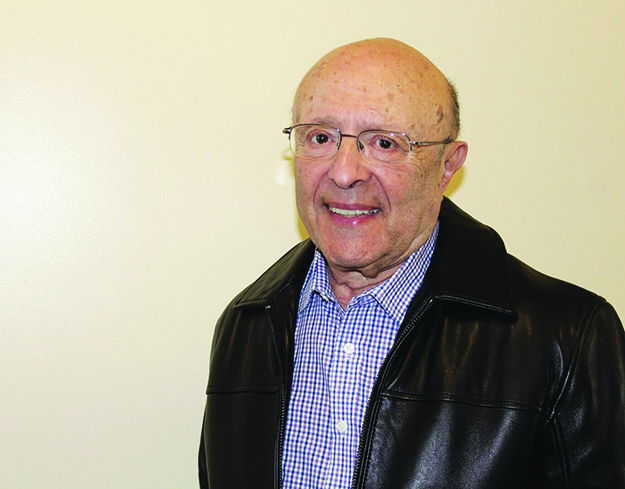
By Kalvin Valdillez, Tulalip News
Autism is a common, yet very complex, developmental disability that has been on the rise in recent times. According to the Centers for Disease Control and Prevention, one in sixty-eight children in the United States have a form of autism. People with an autistic disorder often show significant language delays, repetitive behavior as well as social and communication challenges; and often times have experienced emotional and/or physical trauma. Children with autism are usually diagnosed by the age of four, as signs begin to show at a young age such as having obsessive interests, having trouble understanding others’ feelings and not responding by name.
Reflective Network Therapy (RNT) is a method which helps children with autism, between the ages of two and seven, in a classroom setting. Developed by Dr. Gilbert Kliman in 1965, RNT has assisted over 1,800 developmentally and emotionally disabled children including many foster care children.
“The method involves working with the child in a play therapy session, twenty minutes at a time, every school day,” explains Dr. Kliman. “Each child is worked with every day by a play therapist right in the classroom. Before that therapy session, the teacher briefs the child and the therapist about what the child’s been doing that day – in class and at home. Often the parent has dropped off the child and said ‘Johnny had a bad dream’, ‘Johnny said a whole lot of new words yesterday that we didn’t know he could say’, ‘he started to read’ or ‘he got into trouble’. The teacher uses a very small amount of time, just a minute or two, to condense that information for the therapist. After the twenty-minute play therapy session, the child and the therapist do the same thing in reverse – they debrief the teacher. ‘Johnny has been playing with dogs and cats. The cats had babies and Johnny seemed to be upset about the cats having babies’ and the teacher hears that.
“Meanwhile, other children are allowed to help each session – the children who are not having problems can help the special needs child,” he continues. “For example, he might not know how to play very well, so the more skilled children can teach him how to play and can teach him how to talk and behave. In that process the regular kids become very helpful and altruistic. It’s good for them to learn they can be helpful in their own communities to their own peers. Parents do something similar every week, they get together with the teacher or the therapist and share information about the child, they brief and debrief each other. This establishes a network in which everybody in the classroom has a part in bringing the community’s healing force to a special needs child. We’re finding this very helpful for children who have been through trauma, like domestic violence or having to move from one home to another home – often foster homes. It’s very helpful for children with developmental problems like autism.”
Often referring to RNT as ‘community based’, Dr. Kliman believes that it is important for the child to be in an environment where they feel safe and comfortable. For the past year, Dr. Kliman worked with the Betty J. Taylor Early Learning Academy to implement RNT for the children of the Academy who are either autistic, in beda?chelh, or experienced some form of trauma. Dr. Kliman believes that tribal communities who have their own early learning programs can benefit greatly from RNT.
“The unique part about this method is that it’s evidenced-based and can be carried out in a child’s regular school,” he states. “It’s particularly valuable for Native American special needs children that they be treated in their tribe’s own school and learn their native languages rather than be bussed to a distant white school, which I think was a terrible mistake that happened a long time ago and still haunts Native American communities to this day – the boarding school experience. Native American special needs children go through an unfortunate repetition of that exclusionary experience and what I’m bringing for the past couple years is a message that we can include special needs children at the Betty J. Taylor Center just as it has been done in other preschools.
“I have seen some children get much brighter,” says Dr. Kliman of the kids he is working with at the Early Learning Academy. “I have seen some very agitated hyper-active children become calm and focused without medication – not one of the about 15 children we’ve worked with has been given medication by us. We prefer, in fact, to take children off any medication they’re on because at this age we feel it’s really risky for children to be on some of these powerful medications. We’ve seen mute children become talkative, we have seen some autistic children become well-related, a trans-gender child become more self-confident. We have some children become kinder to themselves, children who use to hurt themselves become more self-respecting and safer. I think the best effect is, in general, children seem to like themselves better with this treatment, they feel self-respect. They absorb the respect of the therapist, teacher, peers and parents so they can feel it’s worthwhile to be themselves. This treatment is a community treatment in which the community of the classroom is harnessed for the good of the individual child.”
In 2011, Dr. Kliman published the book Reflective Network Therapy in the Preschool Classroom to share his method with the world and was met with rave reviews and several awards. The book featured testimonies from many of the children, now adults, affected by RNT. Although there are several different methods, theories and approaches to autism are that there is no cure for the disability as of yet. However, RNT appears to be the most effective treatment to date. In a twice-tested study, a group of seventy-nine autistic and special needs children showed significant improvements to their IQ scores while using Dr. Kliman’s RNT method, with an average increase of fifteen points. One child in particular went from an IQ score of fifty-two to a score of ninety-one during the course of one school year.
“There are about eighty kids we’ve now tested twice for IQ,” he explains. “From nine different projects. From Michigan, Seattle, San Francisco, San Mateo, Argentina and White Plains, New York, we put them all together and the unusual thing about it is almost all the children had a rise of IQ – and they’re all special needs kids. Ordinarily when a kid is traumatized by watching a lot of domestic violence, they do lose some IQ points. This treatment goes the other way; they’re gaining IQ points. It’s not happening with the sixty-three comparison children; in fact, they have no change or slight drops of IQ. These are not significant drops but these are significant gains. We think this is a very sturdy bit of scientific evidence. More importantly, it’s not hard to do and this method seems to work in a lot of different settings.
“There’s a lot of evidence now, in both autism and post-traumatic stress disorder, that there’s some disconnection of brain centers that are ordinarily well-connected, but with those disorders they are not so well-connected. For example, loving and learning centers are not well-connected in autism or post-traumatic stress disorder. Whereas in this treatment, we try to help the child feel cared about and understood in a positive and affectionate way, by the whole school community, and that seems to help the brain grow. It particularly helps the connections in the brain grow. The better all the parts in the brain work together, the stronger and more resilient the individual is.”
For further information regarding RNT please visit www.ChildrensPsychologicalHealthCenter.org or contact Kathryn McCormick, of the Betty J. Taylor Early Learning Academy, at (360) 716-4064.
5th graders make a splash at Seattle Aquarium
By Micheal Rios, Tulalip News. Photos courtesy of Malory Simpson
Four 5th grade classes at Quil Ceda Tulalip Elementary (QCT) were provided with the exciting opportunity to experience all that the Seattle Aquarium has to offer on Friday, September 19.
Interesting fact, the Seattle Aquarium is the ninth largest aquarium in the United States by attendance and among the top five paid visitor attractions in the Puget Sound region. Bolstering those stats are an additional 96 QCT students, accompanied by teachers and chaperones, who made the field trip to the region’s premier resource for hands-on marine experiences.
“My favorite thing about the student’s field trip was seeing how eager they all were to learn,” said Breezy Distefano, Native Liaison.
“There were so many stations and exhibits throughout the Aquarium setup for the students to interact with,” added Malory Simpson, School Advocate. “They learned a variety of things from details of marine ecosystems to the life cycle of a salmon.”
Being salmon are often viewed as the staple food source of Coast Salish people and the Tulalip Tribes moniker is ‘People of the Salmon’, it is only fitting that the cohort of 5th graders got to learn much about salmon on their trip.
The QCT field trip coincided with the 25th Anniversary of the Salmon Homecoming Celebration held at Waterfront Park, Seattle. Along with the visit to the Aquarium, the students were able to participate in Think Salmon School Days activities.
“My favorite memory of the trip is when we first arrived and the students got to sit and listen to other Native youth drumming and singing as part of the Salmon Homecoming festivities,” marveled Malory. “It is always a beautiful thing to see our students witness other Native students practicing their traditional teachings. It helps to reinforce the ideas and values that our students are being taught at Quil Ceda Tulalip.”
September 27, 2017 syəcəb
Please use the following link to download the September 27, 2017 issue of the syəcəb:
https://www.dropbox.com/s/pm3ta5bfq3l7u99/September%2027%2C%202017%20sy%C9%99c%C9%99b.pdf?dl=0
Taste of Tulalip Oktoberfest 2017: A Bavarian Journey
Pay Tribute to German Tradition by Raising a Beer and Toasting “Feierst Oktoberfest”
Tulalip WA — Holding true to Tulalip Resort Casino fashion, the culinary team will draw from the original Munich Oktoberfest for their first annual Taste of Tulalip Oktoberfest on Friday, September 22 from 6 pm to 9 pm at The Draft Sports Bar and Grill Patio. Sommelier Tom Thompson and Executive Chef Perry Mascitti will showcase authentic German dishes along with imported, local, and domestic Oktoberfest inspired beer at the enjoyable Taste of Tulalip celebration. Tickets are priced at $45 per person, ages 21 and over.
The Draft’s Chef Brent Clarkson carefully prepared the menu with options including hearty platters of Uli’s Famous Brats and Sauerkraut, Beer and Cheese Soup with Bavarian Pretzel Crouton, and a traditional Spätzle Bake (German Spätzle pasta lightly buttered and layered with Black Forest ham and Emmenthaler cheese topped with caramelized onions). Rounding out the selections are a Savory Bavarian Pretzel Bread Pudding with mustard caraway rye cream, Pork Schnitzel “Pops” topped with bacon and wild mushroom cream sauce, and a Cheese and Wurst Display, featuring traditional German frankfurter and classic Weiss Wurst sausages (served with an assortment of cheeses, pickled vegetables, gherkins, and breads).
Tom Thompson’s team will serve up a grand selection of beers from noteworthy breweries featuring: Backwoods Brewing, Deschutes, Dru Bru, Georgetown Brewing, Leinenkugel’s, Sam Adams, Sierra Nevada, Hofbräu, Paulaner, and the Hacker-Pschorr.
“Oktoberfest is a time of year where millions of people gather to celebrate great Bavarian food and beer throughout the world to honor this German tradition,” shares Executive Perry Mascitti. “The good news is you don’t have to purchase a plane ticket to Germany in order to celebrate this Oktoberfest.”
During the evening’s festivities, guests can take their chance with lady luck and enter to win from one of two raffle drawings. The two prizes will each include two tickets to the Robert Cray show on November 17, 2017, one overnight stay at Tulalip (some restrictions may apply) and a $100 dining credit applied to the winner’s room.
Doors open for the Taste of Tulalip Oktoberfest 2017 at 6 pm and tickets are priced at $45 per person all-inclusive. To purchase tickets, call (360) 716-1625. All attendees must be 21 and over.
The Resort didn’t think a one day celebration was enough for this beloved, time honored Bavarian festival, so they started the celebration early at the following eateries, which will feature German fare from September 5 through October 31, 2017:
Cedars Cafe will serve Bavarian style Wiener Schnitzel with warm sweet and sour coleslaw, mashed potatoes; topped with crispy onion straws, lemon beurre blanc, and blackberry sauce. Dessert includes Cedars’ Black Forest Ice Cream Sundae with chocolate ice cream, Kirsch cherry compote, whip cream, and chocolate shavings.
Blackfish Wild Salmon Grill presents their Seared Apple Marinated Duck Breast with apple-duck demi & Thuringer sausage with apple-mustard demi, along with onion potatoes, green beans, red cabbage and bacon and a dessert featuring Apple-Raisin Strudel with vanilla bean ice cream.
Carvery/Hotel Espresso makes their mark with Bavarian Ham Sandwich Black Forest ham on a fresh Bavarian pretzel roll, Munster cheese, dill pickles, and stone ground mustard.
The Draft Sports Bar will offer Pork Schnitzel Pops bite sized pork thinly pounded, skewered, breaded, fried golden brown and topped with bacon and wild mushroom cream sauce. Served with warm bacon potato salad and braised apple and red cabbage.
Tulalip Bay’s menu is embellished for the season with Spicy Sausage and Truffle Potato Fritter with stone ground mustard sauce and a dessert of Linzer Torte with beer ice cream.
Eagles Buffet will offer Amber Ale Braised Beef Brisket with buttered Spätzle in September and Bavarian Pork Ribs with braised red cabbage in October.
For more information about Oktoberfest 2017, visit TulalipResort.com. Don’t forget to wear your lederhosen!
Chairwoman Marie Zackuse to Freeman High School
Freeman High School, now and in the difficult days and nights ahead, the hearts of Tulalip are with you. We are grieving with you. We are praying with you. Words can’t describe the pain that the students, the families and the community are experiencing right now. We know that nothing we can say can bring back the life or the innocence that was lost, we can only offer our love and support during this dark day.
